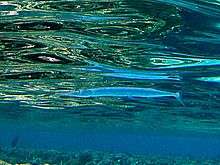Tylosurus choram
Tylosurus choram, the Red Sea houndfish, is a species of needlefish from the family Belonidae. A marine fish bluish in color with a long slender body, and a pointed long toothed beak, found in most temperate, warm seas, and sometimes rivers, It's found in abundance in the Red Sea. It is a fast predator swimming in small schools near the water surface.[2] Like other species of needlefish this species is oviparous, laying eggs which attach themselves to objects in the water by means of filaments which cover the outer layer of the egg.[1] Tylosurus choram is found in the Red Sea and the coasts around the Arabian Peninsula to the Gulf of Oman,[1] it also occurs in the eastern Mediterranean Sea having colonised that sea via the Suez Canal, a Lessepsian migration.[3] This species was described as Belone choram by Eduard Rüppell in 1837 with the type locality given as the Red Sea,[4] the specific name choram is Arabic for needlefish.[5]
| Tylosurus choram | |
|---|---|
 | |
| A Red Sea houndfish | |
 | |
| Scientific classification | |
| Kingdom: | Animalia |
| Phylum: | Chordata |
| Class: | Actinopterygii |
| Order: | Beloniformes |
| Family: | Belonidae |
| Genus: | Tylosurus |
| Species: | T. choram |
| Binomial name | |
| Tylosurus choram (Rüppell, 1837) | |
| Synonyms[1] | |
| |
See also
- List of fishes of the Red Sea.
References
- Froese, Rainer and Pauly, Daniel, eds. (2019). "Tylosurus choram" in FishBase. April 2019 version.
- المعجم الكبير لمجمع اللغة العربية في مصر حرف الخاء الطبعة الأولى 2004 ص 281 The Big Dictionary of the Egyption Arabic Academy, First Edition (2004), the letter (خ) page 281, the word خُرْم
- Daniel Goliani (2009). "Distribution of Lessepsian migrant fish in the Mediterranean". Italian Journal of Zoology. 65 (S1): 95–99. doi:10.1080/11250009809386801.
- Eschmeyer, W. N.; R. Fricke & R. van der Laan (eds.). "Belone choram". Catalog of Fishes. California Academy of Sciences. Retrieved 3 August 2019.
- Christopher Scharpf; Kenneth J. Lazara (15 June 2019). "Order BELONIFORMES (Needlefishes)". The ETYFish Project Fish Name Etymology Database. Christopher Scharpf and Kenneth J. Lazara. Retrieved 3 August 2019.